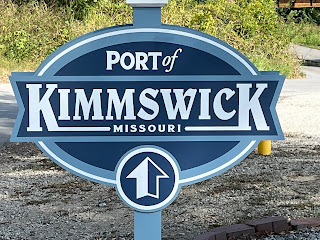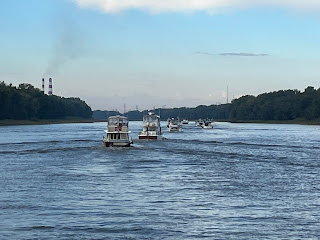Grafton, Illinois at the end of the Illinois River
We woke up eager to get an early
start on our second day of our Journey south on the Illinois River only to be
met by dense fog. We contacted the other loopers in the marina on VHF and we
all decided it would be safer to wait until the fog lifted before heading
out.
However, just as we were settling
into our second cups of coffee/tea, we saw Baker Street Blue (BSB) appear out
of the fog heading past our marina. They had spent the night further north and
had already contacted the next lock about passage. BSB advised us the
visibility was not too bad on the river and, not wanting to miss out on a lock
opening, the rest of us at the marina quickly scrambled to get underway and
follow BSB to the Dresden lock. The fog soon lifted, the sun came out, and our travels that day were pretty easy.
We made
it through both the Dreseden and Marseilles lock without any wait and shortly
after noon we were tied up in Heritage Harbor near Ottawa, Illinois. This was a
very well run facility with a nice pool and restaurant. While Cam and I helped
each other re-install our radar domes that we had removed to get under the bridges
in Chicago, Karen and Heather enjoyed lounging by the pool. That afternoon, the
harbor master, Jeremy, held his daily briefing for all the Loopers. With
notebooks and iPads in hand, we took copious notes about river conditions,
anchorages and marinas we would be seeing along the rest of the Illinois River.
These types of briefings are invaluable in planning for a safe voyage.
Southbound on the Illinois River
Heritage Harbor Marina, Ottawa, Il
We would have loved to stay on at
Heritage for a few days but we needed to keep moving. At 6:45 the next
morning, we left with our buddy boat Sea Clef and 4 other boats. Our first
objective was Starved Rock Lock. We had been advised by the lock they would have to clear through a
few commercial tows before we could lock through so we slowed down to 6 mph
from our usual cruising speed of 9mph. Even with slowing down, when we arrived
at the lock we were advised we would still have to wait. Our options at that
point were to either drift in place or tie up to a "cell" (sometimes referred to as dolphins) near the lock. This
would be a new experience for us. Cells are large round structures built
into waterways, usually near dams, bridges, or locks. They are sometimes built
to be used as a mooring site for boats. Other times they are constructed to
prevent ships from accidentally damaging the structure they are
protecting. In this case, the cell we
were advised to tie up to was a circular structure, approximately 15 feet in
diameter with a corrugated metal skin filled with concrete. There was a single
eye in the middle to tie onto. Over the
previous 6 months we had tied up to a variety of structures….. but never a
round one. Fortunately, the current was not strong. After Karen hung a bunch of
fenders near the middle of our hull, I was able to float us slowly up to this
unforgiving metal structure and Karen was able to scamper off the boat and take
one of our lines to the center eye. I
was then able to pass her a second line. Once we were settled, Cam guided Sea
Clef up to our side and rafted up with us.
Not having been an avid boater for long, new experiences like this cause
Karen a fair amount of anxiety. But she pulled it off like a pro and we could
give ourselves a well-earned high five for a successfully tying our straight
sided hull to an unforgiving round structure without so much as a scratch!

Two of our "Buddy Boats" tied up to a cell
Within less than an hour after
tying up, we got word from the lockmaster that we could proceed into the lock.
We had a lot of company in the lock and we were rafted 4 deep. But it was an
easy drop and, after exiting the lock, we proceeded down river to our
destination for the night, the Henry Lock Wall.
Starved Rock Lock
Barge (Tow) traffic on the Illinois River
Built in 1870 at a cost of
$400,000, the Henry Lock and Dam was the first such structure on the Illinois
River. The river in that area was shallow enough that for much of the year the
river could be crossed by horse and buggy. This made navigation through this
area by boat or barge nearly impossible.
Once completed the river was deep enough for navigation but a nearby
bridge became necessary to allow the horse and buggy traffic to continue to
cross.
In the 1930’s the original bridge
was struck by a barge and damaged beyond repair. (I guess they should have
installed some protective dolphins!) It has since been replaced twice.
Much smaller than the more modern locks, the
old Henry lock was last used in 1927.
The old stone walls are now a popular spot for Loopers to tie up for a
night. There is a small marina next to it and the marina operators also care
for and manage the old wall. To call it rustic would be generous. But it was a
unique place to spend the night. As the walls were rough, irregular and tall,
it was not easy to get on and off the boat. Karen never did make it off the
boat there.
Old Henry Lock Wall
Our next night was in Peoria
Illinois at the Illinois Valley Yacht Club. We got there just in time to purchase
the last few tickets to their annual Lobster Boil. Unfortunately, being the
last folks to get tickets, we were the last to be served and we were still
eating way past “Looper Midnight.” Peoria is the home of Caterpillar Tractors.
We did not go, but we heard they have a great factory tour.
Illinois Valley Yacht Club, Peoria, Illinois
With a somewhat ominous weather
report we set out the next morning with a group of Loopers for what would be
our first night on anchor on the rivers. We dropped the hook behind Quiver
Island near Havana, Illinois. The Anchor set well on the first try. Anchorages
on the rivers are known for having a lot of debris on the bottoms that can snag
anchors so we set the anchor with a “trip line” that would enable us to pull
the anchor out backwards if needed. Although there are a variety of floats that
can be used to locate the trip line, I figured an old plastic jug would work
just as well and help me pass for a “good ole boy.” We could see barge traffic
passing by on the river but we were set well back off the main river and the
setting was quite peaceful. Sea Clef
hosted “docktails” on their boat and later that night we had rain and an
electrical storm show but, fortunately, very little wind.
Anchoring behind Quiver Island
My Hi-Tech float for our anchor trip line
Beautiful sunset was followed by fantastic electrical storm
Weighing anchor the next morning,
Karen got a taste of how much of a pain it is to have to worry about the trip
line but we got it in ok and had beautiful sunny skies for our 33 mile run to
our next unusual spot for a night, tied up to a working barge of Logsdon Tug
Service. The sea (river) wall here at
Beardstown, was a good 30 feet tall and we had to climb a tall wobbly staircase to get up on shore. What doesn’t kill ya only makes ya stronger- right? The
town was "kinda" cute, in a small town America kind of way and we had lunch at a
diner with Cam and Heather and later, docktails on the barge. It was pretty darn hot that day and there was
no electricity on the barge. We ran our generator that evening to run our AC
and top off our batteries. One of the great things about our boat is we have
enough battery power to run one of our ACs overnight. I never met another
Looper who could do that with their boat. We ran our AC that night in our
stateroom and slept soundly in air conditioned bliss and still had over 70%
battery power left in the morning. Thank you Greenline Yachts!


Beardstown Illinois
Tied up for the night to barge at Logsdon Tug Service
We spent the next night on the
docks of Mel’s Illinois Riverdock Restaurant and then continued on to Grafton,
Illinois where the Illinois River ends and joins into the Mississippi! Grafton
was the largest city we had seen since leaving Chicago 1 week before….wow- that
was an interesting week. Grafton Harbor Marina was quite large and impressive.
It was our first experience with covered docks. The Mississippi and Illinois
rivers can have huge floods, with water levels rising 40ft or more. The whole
marina was floating. Not just the
docks…. even the restaurant, offices and pool were floating and the pilings
that supported them were huge- over 40ft hi and 2ft in diameter. We spent 4
days in Grafton relaxing, swimming and hanging with other Loopers. We even took
a chairlift up a hill to have lunch at a winery. There was an incredible view up there of the
Mississippi and we got our first glimpse of the St. Louis arch in the distance, a site we were looking forward to seeing from the water!


Mel's Riverdock Restaurant
Grafton, IL - Key West of the Mid West











































































